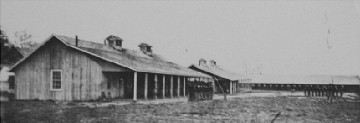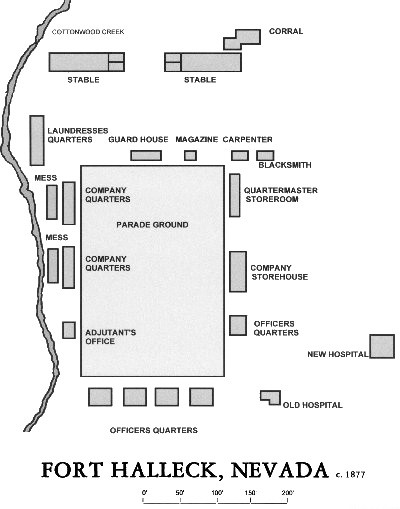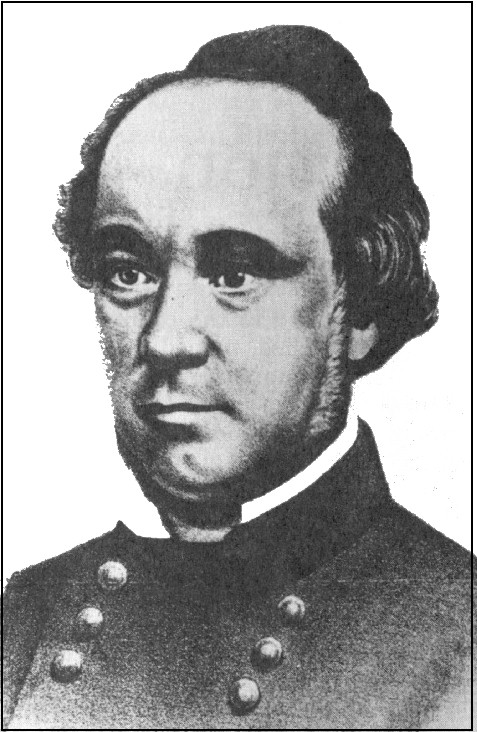HOWARD HICKSON'S
HISTORIES
[Index]
Men in Blue
Fort Halleck, Nevada (1867-1886)
In 1867 Central
Pacific Railroad construction crews were laying rails toward tracks of
the Union Pacific to complete the first transcontinental railroad in the
United States. Back east in Washington, D.C. army brass decided to build
a fort to protect the workers from Indian attacks. It didn't matter that
there had been no battles in northern Nevada in recent years.
Captain S.P. Smith, formerly of Fort Ruby,
was at Winnemucca Ridge when he received orders to found Camp Halleck.
With Lieutenant Augustus Starr (now you know where Starr Valley got its
name) he led Company H, Eighth Cavalry to Cottonwood Creek a few miles
south of Secret Pass.
Once there, Capt. Smith bought property for the
fort (fort or camp, it changed status from time to time, I will use fort
for the sake of continuity) from First Lieutenant William G. Seamonds.
Seamonds had been stationed at Fort Ruby but was retired and had the honor
of being the first settler in what would be Halleck Valley. The post was
named in honor of General Henry W. Halleck (right), Commander-in-Chief
of the US Army in 1867. The new military reservation covered 17 square
miles of grazing areas, forests for wood, and the post proper.
Smith put his soldiers to work constructing
dugouts for the enlisted people and putting up tents for the officers.
Smith was a tough Indian fighter from the Overland War of 1863. He was
also an oppressive leader, always insisting that his men follow military
rules to the letter. If not, they were flogged. One of his reports noted
that of a roster of 70, 15 soldiers, not wanting to face the whip, had
deserted.
Shoshones and Paiutes visited the fledgling
fort to watch the men work. The soldiers, in turn, sometimes traveled to
nearby Indian camps to watch dances. There wasn't any danger from the peaceful
local natives. Occasionally a wagon train detoured from the Humboldt River
to the fort but they too were in no danger.
Food was freighted to the fort from Austin.
The choice didn't vary. There was flour, beef, bacon, beans, coffee, tea,
rice, and sugar - the only delicacy was dried apples. If the men wanted
some variation they patronized a nearby store where they bought eggs at
$2 a dozen, butter for $2.50 a pound, and canned goods were $1 each. Double
that price because the army was paid in greenbacks not accepted by local
merchants who converted them to gold for a 50% commission.
Water was frequently a problem. Cottonwood
Creek dried up part of the year so a ditch was dug from another stream
to the west. Additionally, barrels were filled from a nearby spring and
brought to the camp by wagon. When there was enough water the men planted
gardens in self defense to provide some variation in their diet.
By December, 1868 there were two companies
at Fort Halleck: Company D, Eighth Cavalry, with two officers and 50 enlisted
men and Company H, Eighth Cavalry, with two officers and 64 soldiers. Add
to those one assistant surgeon, one hospital steward, one hospital matron,
and three laundresses. If the math is right, that's 120 people.
More permanent structures were built of cottonwood
logs and adobe. Officers, of course, were assigned to the adobes. They
were more weatherproof.

Fort Halleck about 1878 - Photo
from Northeastern Nevada Museum, Elko.
In 1869 the Central Pacific was completed and
supplies came by railroad, off loading at Halleck Station, about twelve
miles to the north.
By the 1870s, local farmers and ranchers depended
on the fort for entertainment and economic strength. Many soldiers, especially
on payday, took their business to nearby John Day Ranch where there was
a saloon, dance hall, and a stock of professional girls with loose morals.

Drawing by the author.
Attempts were made to bring a little civilization
to the place by wives of men stationed at Fort Halleck. They tried to bring
some semblance of civilization by promoting religious and social
activities. The commanding officer's sister tried converting local Indians
to Christianity. It didn't work out. The services were well attended but
the Indians didn't understand English. They came for the music and refreshments..
Since there was no danger from the Indians,
commanding officers from time to time wrote letters to their headquarters
suggesting closure of the fort. Those efforts were always met with much
resistance from local settlers because their livelihoods were threatened
by the inevitable end had to come someday.
Soldiers from Fort Halleck never fought any
local battles but they still saw plenty of action: 131 men, under the command
of Lt. George R. Bacon, fought in the Modoc War in 1873; 1877 saw troops
from the fort fighting the Nez Perce in Idaho; and, in 1885, they were
involved in the Apache War in Arizona.
Major General O.O. Howard wrote the letter
that started the fort's demise: "There seems to be no good reason why Fort
Halleck, Nevada should not be abandoned. It is 12 miles from the railroad
and possesses no paramount importance as a strategic point. The settlers
are interested in some degree in keeping the Post, in order to have a market
near at hand for grain and other supplies they can raise. It is, considering
its size, the most expensive Post in the Department."
In1886, the Secretary of War finally authorized
abandonment of the military reserve and turning the property over to the
Department of the Interior.
After the soldiers left local settlers moved
in and cannibalized lumber, roofing material, and whatever else they could
use. It is probably there are still ranches with parts of Fort Halleck
in their buildings. It didn't take long for the place to fall into disrepair
and for nature to reclaim the land..
Daughters of Utah Pioneers erected a monument
in 1939 noting the fort's 19 years of service. It is on the south side
of the road. About all that remains today are mounds marking foundations
and cottonwood trees that once bordered the parade ground. Perhaps, with
the right circumstances and frame of mind, a visitor might hear cadence
being called, horses neighing, firearms practice, construction sounds,
and maybe a soldier in quarters playing his harmonica and thinking of the
girl he left behind. Walk a few moments in the past.
Howard Hickson
September 8, 2002
Source: Most of the information in this vignette came
from Halleck Country - The Story of the Land and its People by Edna
B. Patterson and Louise A. Beebe published in 1982.
©Copyright 2002 by Howard Hickson.
[Back to Hickson's
Histories Index]
|


